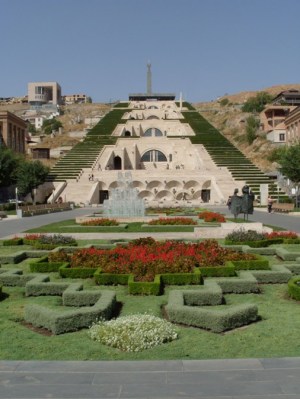 Exterior of the Cafesjian Center for the Arts as pictured on their website: http://www.cmf.am/
Exterior of the Cafesjian Center for the Arts as pictured on their website: http://www.cmf.am/
A significant collection of glass art is among the prize holdings of the three-year-old Cafesjian Center for the Arts, in Armenia’s capital city of Yerevan. The institution is a result of the singular largess of Armenian-American benefactor, glass collector and successful businessman, Gerard L. Cafesjian. Cafesjian was born in Brooklyn in 1925 to Armenian parents profoundly impacted by the Armenian genocide, suffering the loss of many close relatives. After serving overseas in World War II, Cafesjian returned to the U.S. to earn a degree in law and economics. He later began working for West Publishing, the world’s leading supplier of legal information, in which he became the head of advertising and helped the company to expand by over 4,000 employees before becoming its owner. Throughout his economic success, Cafesjian’s Armenian identity remained prominent and informed his philanthropic gestures.
Despite spending most of his career thousands of miles from where Cafesjian spent most of his life, the small modest country appeared to have an intangible yet irrepressible hold on the New Yorker’s emotions, which only intensified after Armenia declared its independence from the former Soviet Union in 1990. Cafesjian first put his nationalistic priorities into action in 1996, when he founded the Cafesjian Family Foundation with the purpose of providing support and encouragement for Armenians in their quest to move on from the Armenian genocide and rekindle a sense of well-being.
This powerful, transatlantic grasp would eventually amount to a similarly unlikely bond: that of the Armenian nation, particularly the quiet capital city of Yerevan, to the contemporary world of glass art. In 2009, Cascade Complex, a rapidly aging structure in the city’s center, was transformed into the Cafesjian Center for the Arts. With its full restoration and with exhibitions installed, Armenian citizens were given a unique look at some of the best work in international Studio Glass. The museum says it has had 1.2 million visitors since it opened 2009.
Currently on display in Gallery One, the museum’s prominent space for glass featuring, is a rotating selection from Cafesjian’s personal collection, including pieces by accomplished artists such as Vlastimil Beranek, Ivan Mares, and Dale Chihuly. Some of the more notable pieces in the collection come from Czech couple Stanislav Libensky and Jaroslava Brychtova. Other past exhibits include Ivana ?rámková‘s “Geometric Forms and Images,” in which her abstract replications of familiar animals inspired the basis for “Creativity and Imagination,” CCA’s first educational program for children.
 Bertil Vallien, Area II Finding, 1991. Sand cast glass, wood, and metal. H 56, W 30, D 30 cm. courtesy: cafesjian center for the arts
Bertil Vallien, Area II Finding, 1991. Sand cast glass, wood, and metal. H 56, W 30, D 30 cm. courtesy: cafesjian center for the arts
From CCA’s impressive attendance numbers, it is obvious that such a remote location for its collection of art does little to pose as an obstacle, but rather an unlikely aid. After all, the art world craves the unexpected, and this is certainly a production that takes the element of surprise to a whole new level.
—Madeleine Harrington



